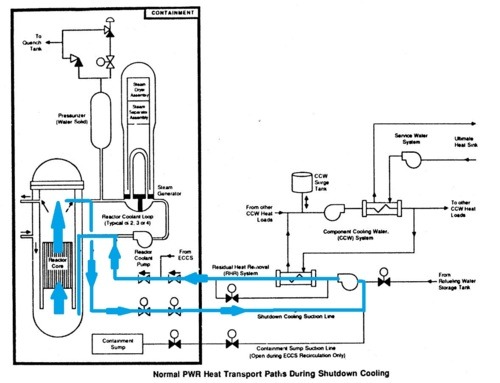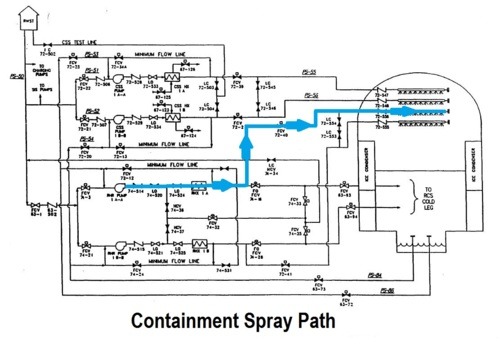
On February 11, 1981, the Unit 1 reactor at the Sequoyah nuclear plant near Soddy-Daisy, Tennessee was shut down. The residual heat removal (RHR) system was operating in its shutdown cooling mode to remove decay heat produced by the reactor core. An RHR pump removed water from the reactor vessel, sent it through a heat exchanger to cool it down several degrees, and returned it to the reactor vessel (see figure above).
An auxiliary unit operator (AUO) who was inside the containment building was talking on an in-plant phone to an operator inside the control room about a test they were conducting. The AUO misunderstood an instruction he had been given and opened the wrong valve. The opened valve created a pathway for the RHR system to send water to the containment spray header. The spray header has a carwash-style array of piping and nozzles mounted to the domed ceiling of the containment building (see figure below).

During an accident, this system can be used to spray water into the containment to cool down the building’s air and steam atmosphere. During this miscue, it was used to spray nearly 110,000 gallons of water from the refueling water storage tank and the reactor vessel into the containment building.
The AUO realized his mistake almost immediately. Standing inside the containment building, he was in a perfect spot to see, and perhaps feel, the water pouring from the spray nozzles. The AUO tried to relay that crucial bit of information to the control room operator. Unfortunately, the control room operator did not have time to talk. He had an emergency on his hands – the water level inside the reactor vessel was decreasing. He hung up on the AUO to respond to the crisis.
Reactor water sprayed into the containment building for about 10 minutes before the link between cause and effect could be established and steps taken to correct the problem.
Our Takeaway
The RHR system is one of the most versatile systems in a nuclear power plant. It can cool the reactor core during shutdown, low power, and accident conditions. It can cool the containment during an accident. It can flood and drain the refueling cavity during refueling outages. In some boiling water reactors, it can cool the spent fuel pools. It’s like a nuclear-plant Swiss army knife.
The versatility comes at a price. Time after time, RHR systems have inadvertently drained water from the reactor vessel. In this case, reactor water drained from the reactor vessel and was sprayed into containment. At Wolf Creek, the RHR system drained water from the reactor vessel to the refueling water storage tank. The RHR system at some boiling water reactors drained reactor water into the suppression pool. And when conducting a post-refueling test at Hatch, I drained reactor water from the reactor vessel into long sections of RHR system piping that had been emptied earlier during the refueling outage.
Versatility is a two-sided coin – just as you can do a lot of good things with a versatile system, you can do many bad things too. With so many potential lineups for a versatile system, it takes maximum attention to detail to ensure the lineup you get is the one you want.
“Fission Stories” is a weekly feature by Dave Lochbaum. For more information on nuclear power safety, see the nuclear safety section of UCS’s website and our interactive map, the Nuclear Power Information Tracker.
